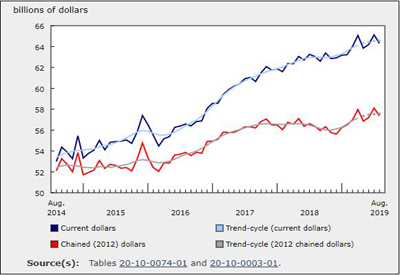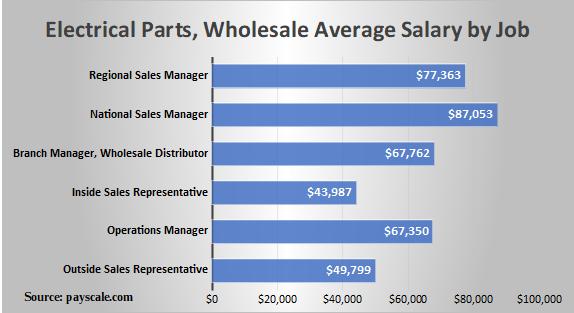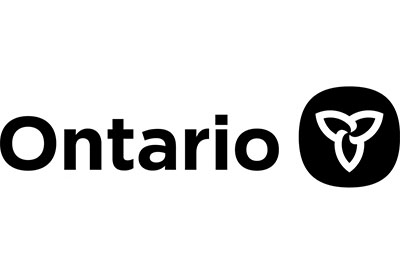Wholesale Sales Declined 1.2% in August

Oct 29, 2019
Wholesale sales were down 1.2% to $64.3 billion in August, largely offsetting the 1.4% gain in July. Declines were recorded in five of seven subsectors, representing 85% of wholesale sales.
In dollar terms, the machinery, equipment and supplies, the personal and household goods, and the motor vehicle and motor vehicle parts and accessories subsectors contributed the most to the decline in August. In volume terms, wholesale sales decreased 1.3%.
Decrease in August attributable to lower sales in five of seven subsectors
The machinery, equipment and supplies subsector decreased for the second consecutive month, down 2.6% to $13.3 billion in August. Sales declined in three of four industries, with the construction, forestry, mining, and industrial machinery, equipment and supplies industry contributing the most to the downward movement. During the same period, imports of logging, construction, mining, and oil and gas field machinery and equipment also fell.
Following a 4.7% gain in July, the personal and household goods subsector decreased 3.4% to $9.4 billion in August, with declines reported in five of six industries. In dollar terms, sales in the textile, clothing and footwear, and the pharmaceuticals and pharmacy supplies industries contributed the most to the decrease. Imports of clothing, footwear and textile products, and pharmaceutical and medicinal products were also down in August.
Lower sales were also reported in the motor vehicle and motor vehicle parts and accessories (-1.2% to $11.3 billion), miscellaneous (-0.7% to $8.3 billion) and food, beverage and tobacco (-0.4% to $12.1 billion) subsectors.
Ontario and Quebec lead wholesale declines in August
Sales declined in every province except Alberta in August, representing 89% of wholesale sales. Much of the decline was attributable to lower sales in Ontario and Quebec.
Ontario reported lower sales for the first time in three months, down 1.5% to $33.4 billion. Despite this decline, Ontario wholesale sales for August were up 4.1% year over year. Five of seven subsectors recorded lower sales, led by the personal and household goods and the machinery, equipment and supplies subsectors. The personal and household goods subsector decreased 4.2% to $5.3 billion in August, the second monthly decline in 2019. The machinery, equipment and supplies subsector was down 2.5% to $6.9 billion in August, with the other machinery, equipment and supplies industry accounting for the majority of the decline.
In Quebec, wholesale sales were down 2.0% to $12.0 billion, the largest dollar-value decline since January 2017 and the sixth-largest monthly decrease for the province since 1993. Despite the decline, Quebec wholesale sales were up 5.5% year-to-date, compared with the first eight months of 2018. The personal and household goods subsector recorded the largest monthly decrease, down 5.4% to $2.7 billion, following five consecutive monthly increases. The machinery, equipment and supplies subsector, down 5.4% to $1.8 billion in August, recorded the second-largest decline for the province. Lower sales in the subsector were primarily attributable to declines in the construction, forestry, mining, and industrial machinery, equipment and supplies industry.
Inventories fall for first time in 12 months
Following 11 consecutive monthly gains, wholesale inventories declined 0.3% to $93.4 billion in August. Decreases were recorded in five of seven subsectors, which together represented 70% of total wholesale inventories.
Inventories in the motor vehicle and motor vehicle parts and accessories subsector declined for the first time in four months, down 1.0% to $13.5 billion. Decreases were recorded in two of three industries, led by the motor vehicle industry.
In the miscellaneous subsector, inventories fell 1.1% to $11.6 billion as four of five industries recorded declines in August.
Wholesale inventories in the personal and household goods subsector declined for the first time since November 2018, down 0.4% to $16.1 billion. The textile, clothing and footwear, and the personal goods industries recorded the only declines within the subsector in August.
The inventory-to-sales ratio increased from 1.44 in July to 1.45 in August as declines in sales overshadowed those in inventories. The inventory-to-sales ratio is a measure of the time (in months) required to exhaust inventories if sales were to remain at their current level.
Source: Statistics Canada, https://www150.statcan.gc.ca/n1/daily-quotidien/191023/dq191023a-eng.htm











